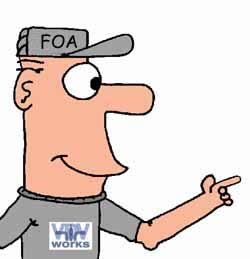
- Lennie Lightwave's
- Guide To Fiber Optics
Networks
Fiber Optic Networks
In the telcos, singlemode fiber is used to connect long distance switches, central offices and SLCs (subscriber loop carriers, small switches in pedestals in subdivisions or office parks or in the basement of a larger building). Practically every telco's network is now all fiber optics except the connection to the home.
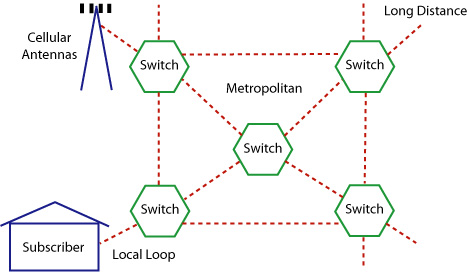
Fiber to the home (FTTH) is now cost effective - especially since most homes want the high speed services that would justify fiber optics. FTTH is the big focus of communications today.
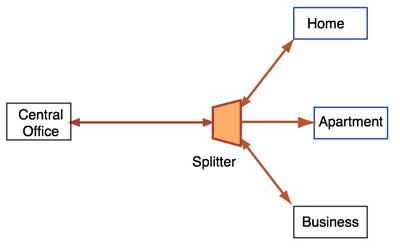
CATV companies "overbuild" with fiber. They lash fiber cable onto the aerial "hardline" coax used for the rest of the network or pull it in the same conduit underground. The fiber allows them to break their network into smaller service areas that prevent large numbers of customers from being affected in an outage, making for better service and customer relations. The fiber also gives them a return path which they use for Internet and telephone connections, increasing their revenue potential.
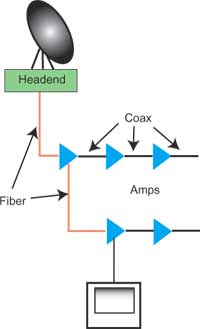
LANs (local area networks) use fiber optics primarily in the backbone but increasingly to the desk. The LAN backbone often needs longer distance than copper cable (Cat 5/5e/6) can provide and of course, the fiber offers higher bandwidth for future expansion. Most large corporate LANs use fiber backbones with copper wire to the desktop. Fiber to the desk can be cost effective if properly designed.
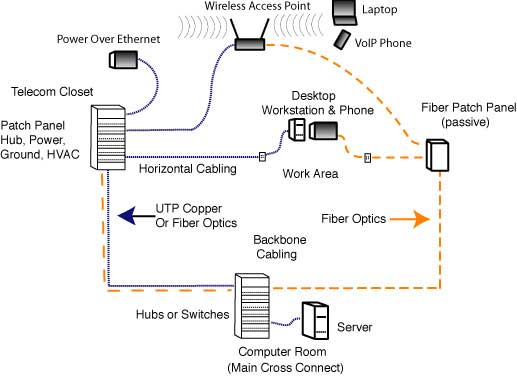
The latest development in LANs is using FTTH passive optical LANs which have proven to be cheaper than traditional LANs and easier to upgrade. See "Centralized Fiber And OLANs" below.
Lots of other networks use fiber. CCTV is often on fiber for it's distance capability. Industrial plants use lots of fiber or distance and noise immunity. Utilities use it for network management and "smart grid" control, liking its immunity to noise also. The military uses it because it's hard to tap or jam. Airplanes use it for that reason too, but also like the lighter weight of fiber.
Designing Cable Networks
This is too big a topic for a overview! But we'll pass along some hints to make life easier. First and foremost, visit the work site and check it out thoroughly. Know the "standards" but use common sense in designing the installation. Don't cut corners which may affect performance or reliability. Consider what are the possible problems and work around or prevent them. There ain't no substitute for common sense here!
Fiber's extra distance capability makes it possible to do things not possible with copper wire. For example, you can install all the electronics for a network in one communications closet for a building and run straight to the desktop with fiber. With copper, you can only go about 90 meters (less than 300 feet), so you need to keep the electronics close to the desk. With fiber, you only need passive patch panels locally to allow for moves. Upgrades are easy, since the fiber is only loafing at today's network speed!
Is Copper Really Cheaper Than Fiber?
When it comes to costs, fiber optics is always assumed to be much more expensive than copper cabling, but when you consider the extra bandwidth and distance capability of fiber optics, it's generally much cheaper. for telecom, fiber costs only a few percent as much as copper or radio links. In premises cabling (LANs) whatever you look at - cable, terminations or networking electronics - fiber costs more up to ~10Gb/s, but as copper gets faster (e.g. Cat 6) it gets more expensive, leading most users to fiber.
Why Use Fiber?
Why have all the telephone long distance and metropolitan networks been converted to fiber - and they are now starting on fiber to the home? And why are all the CATV systems converted to fiber too? Are their networks that different? Is there something they know we don't?
Telcos use fiber to connect all their central offices and long distance switches because it has thousands of times the bandwidth of copper wire and can carry signals hundreds of times further before needing a repeater. FTTH allows offering new services that require more bandwidth than copper wires and reduces maintenance. The CATV companies use fiber because it give them greater reliability and the opportunity to offer new services, like phone service and Internet connections.
Both telcos and CATV operators use fiber for economic reasons, but their cost justification requires adopting new network architectures to take advantage of fiber's strengths. A properly designed premises cabling network can also be less expensive when done in fiber instead of copper. There are several good examples of fiber being less expensive, so lets examine them.
Industrial Networks
In an industrial environment, electromagnetic interference (EMI) is often a big problem. Motors, relays, welders and other industrial equipment generate a tremendous amount of electrical noise that can cause major problems with copper cabling, especially unshielded cable like Cat 5. In order to run copper cable in an industrial environment, it is often necessary to pull it through conduit to provide adequate shielding.
With fiber optics, you have complete immunity to EMI. You only need to choose a cable type that is rugged enough for the installation, with breakout cable being a good choice for it's heavy-duty construction. The fiber optic cable can be installed easily from point to point, passing right next to major sources of EMI with no effect. Conversion from copper networks is easy with media converters, gadgets that convert most types of systems to fiber optics. Even with the cost of the media converters, the fiber optic network will be less than copper run in conduit.
Long Cable Runs
Most networks are designed around structured cabling installed per EIA/TIA 568 standards. This standard calls for 90 meters (295 feet) of permanently installed unshielded twisted pair (UTP) cable and 10 meters (33 feet) of patchcords. But suppose you need to connect two buildings or more? The distance often exceeds the 90 meters by the time you include the runs between the buildings plus what you need inside each building.
By the time you buy special aerial or underground waterproof copper cable and repeaters, you will usually spend more than if you bought some outside plant fiber optic cable and a couple of inexpensive media converters. It's guaranteed cheaper if you go more than two links (180 meters.)
Centralized Fiber LANs And OLANs
When most contractors and end users look at fiber optics versus Cat 5e cabling for a LAN, they compare the same old copper LAN with fiber directly replacing the copper links. The fiber optic cable is a bit more expensive than Cat 5e and terminations are a little more too, but the big difference is the electronics which are $200 or more per link extra for fiber.
However, the real difference comes if you use a centralized fiber optic network - shown on the right of the diagram above. Since fiber does not have the 90 meter distance limitation of UTP cable, you can place all electronics in one location in or near the computer room. The telecom closet is only used for passive connection of backbone fiber optic cables, so no power, UPS, ground or air conditioning is needed. These auxiliary services, necessary with Cat 5 hubs, cost a tremendous amount of money in each closet.
In addition, having all the fiber optic hubs in one location means better utilization of the hardware, with fewer unused ports. Since ports in modular hubs must be added in modules of 8 or 16, it's not uncommon with a hub in a telecom closet to have many of the ports in a module empty . With a centralized fiber system, you can add modules more efficiently as you are supporting many more desktop locations but need never have more than a one module with open ports.
Optical LANs (OLANs) use FTTH passive optical network technology to reduce capital and operating costs and installation time. These networks use splitters to replace switches in the network.
High Speed Networking
As network speeds increase, fiber is always there first. It was over a year after Gigabit Ethernet (GbE) became available on fiber optics that it finally become available on Cat 5e. It took another couple of years before GbE on copper became less expensive. In order to get GbE to work over Cat 5e, the electronics had to be very complicated, and consequently as expensive as fiber. Plus they used five times as much power! The same process occurred with 10Gb Ethernet, but on a longer time frame. And copper past 10G is still in the lab, with distances expected to be severely limited. Fiber is already at 100G and moving up!
Bottom Line
So when it comes to costs, looking at the cabling component costs may not be a good way to analyze total network costs. Consider the total system and you may find fiber looks a lot more attractive.
